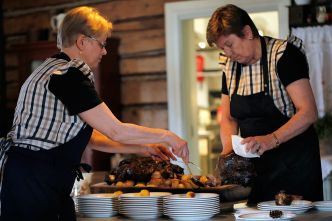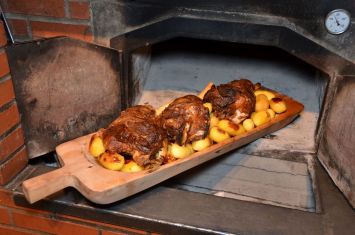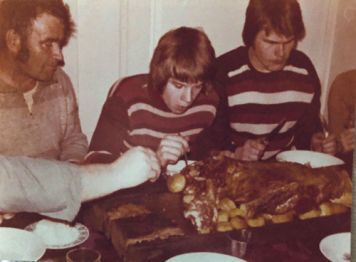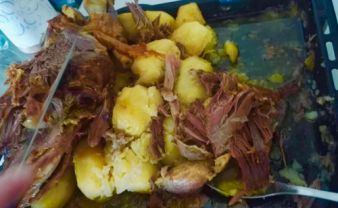Särä tradition in Lemi
| Särä tradition in Lemi | ||||
|---|---|---|---|---|
| In the national inventory | ||||
|

Practitioners and people who know the tradition well
Särä has been an everyday dish in Lemi households, where sheep were raised, and potatoes were cultivated. When Pastor Niilo Kattelus got to taste särä, it served as an inspiration to appoint it to be a traditional delicacy. In the 1950s, especially the Martha Association worked to promote this culinary tradition. The Lemi Local Heritage Society also considered särä an important tradition to preserve. The first särä festival was organized by the association in Niemi’s house in 1970. In 1972, Lemi’s särä was chosen as one of Finland's Seven Wonders in a competition organized by the Finnish Local Heritage Federation, Suomen Matkailuliitto (the Finnish Tourism Federation), and Finnair. Academician Kustaa Vilkuna chaired the judging panel. Särä was the only culinary wonder among the seven. Starting the very next year in 1973, Lemi Local Heritage Society began roasting and offering särä in a restaurant-like setting. Since then, the Lemi Kotiseutuyhdistys museum and its Särätupa (Särä Room) have been well-known for their särä not only in South Karelia but also nationwide and even internationally.

Säräpirtti Kippurasarvi was another restaurant in Lemi that commercially serves särä. The premises were closed at least temporary in 2023. The restaurant began when Lea and Tauno Hietaranta started preparing särä at their home in Lemi's Pöllölä school, alongside their bakery production, in 1978. Ten years later, the operation moved to Lemi's center, and the restaurant was named Säräpirtti Kippurasarvi.The only commericially sold Särä can be found from the Lemi Local Heritage Society. Särä was included as one of the traditional foods during the traditional food days organized by Lemi Martat in the past at the local heritage museum. Särä is still served in Lemi homes, and the skill has not been lost, as lamb continues to be enjoyed by people of all ages. Closely linked to the särä tradition is also the tradition of baking ohrarieska (barley bread), as särä is typically eaten with rieska and homebrewed beer. The tradition of baking rieska, including commercially, has also been well-preserved in Lemi.
Practising of the tradition
The ingredients for Lemi's särä are lamb roast, potatoes, and salt. The preparation of särä, including heating the oven, takes about nine hours. The salted lamb meats are placed in a särä dish bowl (säräkaukalo) on top of alder sticks and roasted in a hot oven. Once the meats are cooked, partially boiled potatoes are added underneath, and the roast is simmered in the oven. Lemi's särä restaurants serve särä to tens of thousands of visitors annually, both locals and those from afar. The vacuum-packed särä roasts, potatoes, and roast fat from Säräpirtti Kippurasarvi have opened up new opportunities for särä enjoyment, not only in Lemi but also elsewhere. This allows särä to be enjoyed in places like Lappeenranta and during the Easter season in several other cities, including Helsinki. The restaurant also operates an online store, making it possible for särä enthusiasts across Finland to enjoy Lemi's särä. Lemi's särä is not a protected name, and its simple recipe has spread widely. Therefore, särä restaurants have been established in places other than Lemi, such as Juva in Southern Savonia. "When things are going poorly, you can only afford to eat särä," was a saying in Lemi homes, where särä was made from local ingredients: lamb and potatoes. The lamb roasts roasted in a särä bowl were well-preserved in the pantry for later use. However, the keeping of sheep declined in Finland after the country joined the European Union, and the price of lamb meat collapsed in the 1990s. Nevertheless, dedicated fans of lamb meat and särä still find a lamb shoulder or leg and roast it with potatoes for Easter and Christmas; ham makes way for särä. In many households, the särä bowl has been replaced by a baking sheet and an electric oven instead of a stone oven. Leftover lamb bones and meat scraps have been used to make särä soup similar to meat soup. It can also be cooked in a large pot, such as what Lemi Local Heritage Society and Lemin Maaseutunaiset (Lemi Rural Women's Association) have done. Särä roast can also be used as a topping for pizza and burgers, as the Lemi-based Jehu restaurant has discovered.
The background and history of the tradition
The use of ovens has been the foundation of Lemi cuisine, including the origin of särä. The Swedish-German-style brick oven came into use in Finland in the 1100-1200s. An even older type of oven, the grate stove placed on a wooden platform, has been used in East Karelia. The word "särä," meaning a meat bowl, is known beyond South Karelia, including in the Karelian Isthmus, Southern Savonia, Kymenlaakso, and Eastern Uusimaa.

For preservation purposes, meat has been roasted in särä bowl not only in Lemi but also in other places like Joutseno, Lappee, Luumäki, Nuijamaa, Ruokolahti, Savitaipale, Suomenniemi, Taipalsaari, and Ylämaa. Lamb meat was roasted in the oven and stored in a pantry to be eaten later as cold meat. At the same time, a ready-to-eat meal could be prepared, which has remained the primary purpose of särä to the present day. The Lemi särä bowl, carved from birch wood, is a more advanced version than, for example, the open-ended bowl used in Ruokolahti. The Lemi bowl allows for the collection of cooking fat. Small holes with plugs were made in the bowl, through which the fat could be drained into a separate container during cooking. Bowls with holes have since fallen out of use. In place of potatoes, which are now part of the särä meal, turnips were used in the past. Combining vegetables and meat in this way is a relatively recent practice. Subsequently, fatty meat and potatoes have been recognized as a tasty combination, which has been the basis of the success of Lemi's särä.
The transmission of the tradition

The tradition of eating särä is still strong in Lemi and among the people of Lemi, but the traditional method of preparing it in a wooden trough in the oven is fading. Särä preparation is not taught in Lemi schools; only the 8th-grade home economics optional groups briefly hear about it in the context of Eastern Finnish culinary heritage. At that time, särä is only briefly mentioned. Fifth-grade students from schools take field trips to the local heritage museum and have the opportunity to peek into a särä oven if särä cooking happens to be in progress. Särä cooking courses have not been organized by the adult education center, Martat, or Maaseutunaiset (rural women's organization). The transmission of the särä home-cooking tradition to new generations is therefore left to individual families.
The future of the tradition
The tradition of eating särä at homes and restaurants is still going strong. One-fifth of Säräpirtti Kippurasarvi's customers are foreigners. Besides Russians, Italians, Germans, and Spaniards have also discovered särä. First, the coronavirus epidemic and then the closing of the border to Russian tourists changed the distribution, reducing the number of foreign visitors. The commercial success of särä is overshadowed by the rising cost of meals and the decline in meat consumption, although the lower carbon footprint of lamb compared to beef could speak in favor of särä. To maintain Lemi's särä as a local specialty and a tourism asset, it should be protected as a brand. As part of the identity of Lemi, särä holds a strong position and is likely to continue as such. In 2018, Lemi earned the title of the world's metal capital. At the metal music festival held in August 2019, the Lemi All Stars band's new song told the recipe for särä: "Särät kaakkoon ja potut kaukaloon, useampi tunti joutenoloo" ("Särät to the maximum and potatoes in the trough, several hours of leisure").
The community/communities behind this submission
Bibliography and links to external sources of information
Online sources
Lemin Kotiseutuyhdistyksen Särätupa
Lemin kirjava: Särästä Suomen kulttuurimatkailun kärkituote
Lemin kirjava: Pottupöydässä muisteltiin myös särää
Yle: Suomen seitsemäs ihme taipuu kotiuuniin
Videos
Ylen Elävä arkisto: Lemin särä
Bibliography
Anu Talka: Rakenteet elävät ajassa/Lemin ihmeet teoksessa Pitäjä ison kiven takana - Lemin historia (toim. Anu Talka 2009) Mikko Europaeus: Kansankulttuuri/Ruokatalous teoksessa Pitäjä ison kiven takana - Lemin historia (toim. Anu Talka 2009)
Converstions and interviews for the article
Irmeli Uski, Vainikkalan Martat 13.8.2019
Lemin Kotiseutuyhdistyksen puheenjohtaja Heikki Haiko 14.8.2019
Lemin koulukeskuksen kotitalouden lehtori Anu-Mari Härkönen 14.8.2019
Liisa Haiko, Jokivarren Martat 15.8.2019
Tuija Kinnunen, Lemin Maaseutunaiset 15.8.2019
Säräpirtti Kippurasarven toimitusjohtaja Esko Hietaranta 16.8.2019
Terttu Rossi, Lemin Maaseutunaiset 16.8.2019 ja 19.8.2019
